自定义拦截器
自定义拦截器
Struts自带的拦截器有35个之多。例如:输入验证是由名为validation拦截器处理的,如果禁用该拦截器,输入验证将停止工作;文件上传如此简单和顺利,要感谢名为fileUpload的拦截器。
Struts自带的默认拦截器足以满足绝大多数的应用程序的需要,但迟早会遇到需要自己建立一个拦截器的时候,这就是自定义拦截器。
二、Struts自带的拦截器
拦截器的使用必须先遵循先编写拦截器、再定义后使用的原则。我们所使用的默认拦截器其实都是Struts之前已经编写好了的,并且在某个配置文件中进行了定义,这个文件便是存放在Struts的发行包中,具体位置为struts2-core-*.jar(*为版本号)中的struts-default.xml文件中。
<interceptors>
<interceptor name="alias" class="com.opensymphony.xwork2.interceptor.AliasInterceptor"/>
<interceptor name="autowiring" class="com.opensymphony.xwork2.spring.interceptor.ActionAutowiringInterceptor"/>
<interceptor name="chain" class="com.opensymphony.xwork2.interceptor.ChainingInterceptor"/>
<interceptor name="conversionError" class="org.apache.struts2.interceptor.StrutsConversionErrorInterceptor"/>
<interceptor name="cookie" class="org.apache.struts2.interceptor.CookieInterceptor"/>
<interceptor name="clearSession" class="org.apache.struts2.interceptor.ClearSessionInterceptor" />
<interceptor name="createSession" class="org.apache.struts2.interceptor.CreateSessionInterceptor" />
<interceptor name="debugging" class="org.apache.struts2.interceptor.debugging.DebuggingInterceptor" />
<interceptor name="externalRef" class="com.opensymphony.xwork2.interceptor.ExternalReferencesInterceptor"/>
<interceptor name="execAndWait" class="org.apache.struts2.interceptor.ExecuteAndWaitInterceptor"/>
<interceptor name="exception" class="com.opensymphony.xwork2.interceptor.ExceptionMappingInterceptor"/>
<interceptor name="fileUpload" class="org.apache.struts2.interceptor.FileUploadInterceptor"/>
<interceptor name="i18n" class="com.opensymphony.xwork2.interceptor.I18nInterceptor"/>
<interceptor name="logger" class="com.opensymphony.xwork2.interceptor.LoggingInterceptor"/>
<interceptor name="modelDriven" class="com.opensymphony.xwork2.interceptor.ModelDrivenInterceptor"/>
<interceptor name="scopedModelDriven" class="com.opensymphony.xwork2.interceptor.ScopedModelDrivenInterceptor"/>
<interceptor name="params" class="com.opensymphony.xwork2.interceptor.ParametersInterceptor"/>
<interceptor name="actionMappingParams" class="org.apache.struts2.interceptor.ActionMappingParametersInteceptor"/>
<interceptor name="prepare" class="com.opensymphony.xwork2.interceptor.PrepareInterceptor"/>
<interceptor name="staticParams" class="com.opensymphony.xwork2.interceptor.StaticParametersInterceptor"/>
<interceptor name="scope" class="org.apache.struts2.interceptor.ScopeInterceptor"/>
<interceptor name="servletConfig" class="org.apache.struts2.interceptor.ServletConfigInterceptor"/>
<interceptor name="sessionAutowiring" class="org.apache.struts2.spring.interceptor.SessionContextAutowiringInterceptor"/>
<interceptor name="timer" class="com.opensymphony.xwork2.interceptor.TimerInterceptor"/>
<interceptor name="token" class="org.apache.struts2.interceptor.TokenInterceptor"/>
<interceptor name="tokenSession" class="org.apache.struts2.interceptor.TokenSessionStoreInterceptor"/>
<interceptor name="validation" class="org.apache.struts2.interceptor.validation.AnnotationValidationInterceptor"/>
<interceptor name="workflow" class="com.opensymphony.xwork2.interceptor.DefaultWorkflowInterceptor"/>
<interceptor name="store" class="org.apache.struts2.interceptor.MessageStoreInterceptor" />
<interceptor name="checkbox" class="org.apache.struts2.interceptor.CheckboxInterceptor" />
<interceptor name="profiling" class="org.apache.struts2.interceptor.ProfilingActivationInterceptor" />
<interceptor name="roles" class="org.apache.struts2.interceptor.RolesInterceptor" />
<interceptor name="jsonValidation" class="org.apache.struts2.interceptor.validation.JSONValidationInterceptor" />
<interceptor name="annotationWorkflow" class="com.opensymphony.xwork2.interceptor.annotations.AnnotationWorkflowInterceptor" />
<interceptor name="multiselect" class="org.apache.struts2.interceptor.MultiselectInterceptor" />
<!-- Basic stack -->
<interceptor-stack name="basicStack">
<interceptor-ref name="exception"/>
<interceptor-ref name="servletConfig"/>
<interceptor-ref name="prepare"/>
<interceptor-ref name="checkbox"/>
<interceptor-ref name="multiselect"/>
<interceptor-ref name="actionMappingParams"/>
<interceptor-ref name="params">
<param name="excludeParams">dojo\..*,^struts\..*</param>
</interceptor-ref>
<interceptor-ref name="conversionError"/>
</interceptor-stack>
<!-- Sample validation and workflow stack -->
<interceptor-stack name="validationWorkflowStack">
<interceptor-ref name="basicStack"/>
<interceptor-ref name="validation"/>
<interceptor-ref name="workflow"/>
</interceptor-stack>
<!-- Sample JSON validation stack -->
<interceptor-stack name="jsonValidationWorkflowStack">
<interceptor-ref name="basicStack"/>
<interceptor-ref name="validation">
<param name="excludeMethods">input,back,cancel</param>
</interceptor-ref>
<interceptor-ref name="jsonValidation"/>
<interceptor-ref name="workflow"/>
</interceptor-stack>
<!-- Sample file upload stack -->
<interceptor-stack name="fileUploadStack">
<interceptor-ref name="fileUpload"/>
<interceptor-ref name="basicStack"/>
</interceptor-stack>
<!-- Sample model-driven stack -->
<interceptor-stack name="modelDrivenStack">
<interceptor-ref name="modelDriven"/>
<interceptor-ref name="basicStack"/>
</interceptor-stack>
<!-- Sample action chaining stack -->
<interceptor-stack name="chainStack">
<interceptor-ref name="chain"/>
<interceptor-ref name="basicStack"/>
</interceptor-stack>
<!-- Sample i18n stack -->
<interceptor-stack name="i18nStack">
<interceptor-ref name="i18n"/>
<interceptor-ref name="basicStack"/>
</interceptor-stack>
<!-- An example of the paramsPrepareParams trick. This stack
is exactly the same as the defaultStack, except that it
includes one extra interceptor before the prepare interceptor:
the params interceptor.
This is useful for when you wish to apply parameters directly
to an object that you wish to load externally (such as a DAO
or database or service layer), but can't load that object
until at least the ID parameter has been loaded. By loading
the parameters twice, you can retrieve the object in the
prepare() method, allowing the second params interceptor to
apply the values on the object. -->
<interceptor-stack name="paramsPrepareParamsStack">
<interceptor-ref name="exception"/>
<interceptor-ref name="alias"/>
<interceptor-ref name="i18n"/>
<interceptor-ref name="checkbox"/>
<interceptor-ref name="multiselect"/>
<interceptor-ref name="params">
<param name="excludeParams">dojo\..*,^struts\..*</param>
</interceptor-ref>
<interceptor-ref name="servletConfig"/>
<interceptor-ref name="prepare"/>
<interceptor-ref name="chain"/>
<interceptor-ref name="modelDriven"/>
<interceptor-ref name="fileUpload"/>
<interceptor-ref name="staticParams"/>
<interceptor-ref name="actionMappingParams"/>
<interceptor-ref name="params">
<param name="excludeParams">dojo\..*,^struts\..*</param>
</interceptor-ref>
<interceptor-ref name="conversionError"/>
<interceptor-ref name="validation">
<param name="excludeMethods">input,back,cancel,browse</param>
</interceptor-ref>
<interceptor-ref name="workflow">
<param name="excludeMethods">input,back,cancel,browse</param>
</interceptor-ref>
</interceptor-stack>
<!-- A complete stack with all the common interceptors in place.
Generally, this stack should be the one you use, though it
may do more than you need. Also, the ordering can be
switched around (ex: if you wish to have your servlet-related
objects applied before prepare() is called, you'd need to move
servletConfig interceptor up.
This stack also excludes from the normal validation and workflow
the method names input, back, and cancel. These typically are
associated with requests that should not be validated.
-->
<interceptor-stack name="defaultStack">
<interceptor-ref name="exception"/>
<interceptor-ref name="alias"/>
<interceptor-ref name="servletConfig"/>
<interceptor-ref name="i18n"/>
<interceptor-ref name="prepare"/>
<interceptor-ref name="chain"/>
<interceptor-ref name="debugging"/>
<interceptor-ref name="scopedModelDriven"/>
<interceptor-ref name="modelDriven"/>
<interceptor-ref name="fileUpload"/>
<interceptor-ref name="checkbox"/>
<interceptor-ref name="multiselect"/>
<interceptor-ref name="staticParams"/>
<interceptor-ref name="actionMappingParams"/>
<interceptor-ref name="params">
<param name="excludeParams">dojo\..*,^struts\..*</param>
</interceptor-ref>
<interceptor-ref name="conversionError"/>
<interceptor-ref name="validation">
<param name="excludeMethods">input,back,cancel,browse</param>
</interceptor-ref>
<interceptor-ref name="workflow">
<param name="excludeMethods">input,back,cancel,browse</param>
</interceptor-ref>
</interceptor-stack>
<!-- The completeStack is here for backwards compatibility for
applications that still refer to the defaultStack by the
old name -->
<interceptor-stack name="completeStack">
<interceptor-ref name="defaultStack"/>
</interceptor-stack>
<!-- Sample execute and wait stack.
Note: execAndWait should always be the *last* interceptor. -->
<interceptor-stack name="executeAndWaitStack">
<interceptor-ref name="execAndWait">
<param name="excludeMethods">input,back,cancel</param>
</interceptor-ref>
<interceptor-ref name="defaultStack"/>
<interceptor-ref name="execAndWait">
<param name="excludeMethods">input,back,cancel</param>
</interceptor-ref>
</interceptor-stack>
</interceptors>
<default-interceptor-ref name="defaultStack"/>
三、Interceptor接口
从技术角度上讲,每个拦截器都是直接或间接地实现了com.opensymphony.xwork2.interceptor.Interceptor接口的java类,该接口的定义如下:
package com.opensymphony.xwork2.interceptor;
import com.opensymphony.xwork2.ActionInvocation;
import java.io.Serializable;
public interface Interceptor extends Serializable {
void destroy();
void init();
String intercept(ActionInvocation invocation) throws Exception;
}
方法说明:
1. init():这个方法将在拦截器被创建出来后立刻被调用,它在拦截器的生命周期内只会调用一次。自定义的拦截器必须实现这个方法对相关资源进行必要的初始化。
2. destroy():这个方法将在拦截器被销毁之前被调用,它在拦截器的生命周期内只会调用一次。自定义的拦截器必须实现这个方法来释放拦截器曾经占用的资源。
3. intercept(ActionInvocation invocation):每拦截到一个动作请求,这个方法就会被调用一次,给拦截器一个机会在该动作开始之前或执行完毕后做些事情。
Struts会依次调用程序员为某个动作而注册的每一个拦截器的intercept方法。在每次调用该方法的时候,都会向它传递一个com.opensymphony.xwork2.ActionInvocation (接口)的实例。一个ActionInvocation对象代表一个给定动作的执行状态,拦截器可以从这个对象获得与该动作相关联的Action对象和Result对象.在完成自己的任务后,拦截器将调用ActionInvocatio的invoke方法前进到动作处理流程的下一个环节.com.opensymphony.xwork2.interceptor.AbstractInterceptor类实现了Interceptor接口,并为init和destroy方法分别提供了一个空白的实现.并非所有的拦截器都需要对某些资源进行初始化和销毁,因此我们自定义的拦截器一般选择继承该类,以节省开发时间.
四.自定义拦截器示例
利用拦截器用于登陆用户是否超时
拦截器
public class SessionInterceptor extends AbstractInterceptor {
private static final long serialVersionUID = 6072772019059317328L;
public String intercept(ActionInvocation invocation) throws Exception {
HttpServletRequest request = ServletActionContext.getRequest();
HttpSession session = request.getSession();
Object o = session.getAttribute("user");
if(o==null)
return "sessionInvalided";
else
return invocation.invoke();
}
}
Struts配置文件
<struts> <constant name="struts.devMode" value="true"></constant> <package name="p1" extends="struts-default"> <interceptors> <interceptor name="sessionCheck" class="cn.sdxhce.interceptor.SessionInterceptor"></interceptor> </interceptors> <global-results> <result name="sessionInvalided">/sessionInvalid.jsp</result> </global-results> <action name="register" class="cn.sdxhce.action.StudentAction"> <interceptor-ref name="sessionCheck"></interceptor-ref> <interceptor-ref name="defaultStack"></interceptor-ref> <result>/result.jsp</result> </action> </package> </struts>
